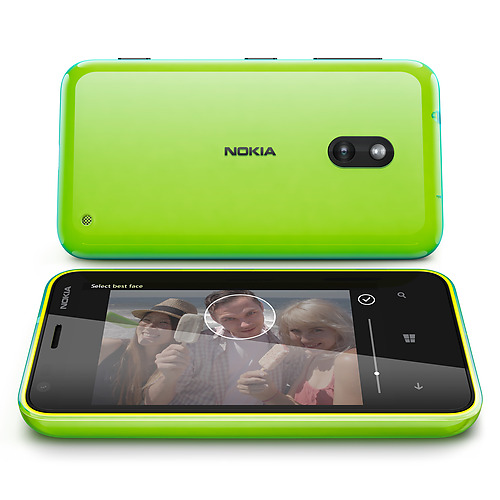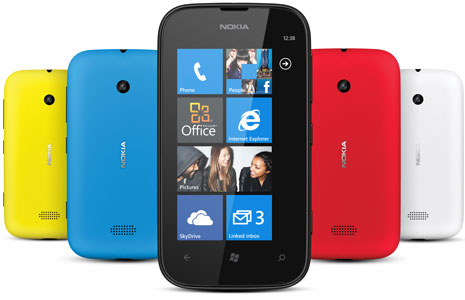Low-end Lumia 620 shows Nokia's and Windows Phone's scaling trouble
Today Nokia announced the Lumia 620, a range of colorful handsets
running Windows Phone 8 that should have an unsubsidized cost of around
$249. The phones will be released in the first quarter of 2013,
initially in Asian and African markets and later in Europe and South
America.
The specs are modest: 3.8-inch 800×480 screen, dual core 1GHz
Snapdragon S4 with 512MB RAM, 5 megapixel rear camera/VGA front camera,
802.11 a/b/g/n, NFC, Bluetooth 3, GPS/GLONASS, 8GB of internal storage, a
microSD slot, in a range of brightly colored interchangeable plastic
cases, 11mm thick and weighing 127g.
The 620 will be available in the four process colors (cyan, magenta,
yellow, black) and white, and to these Nokia is adding two new colors:
lime green and orange. These two colors use a new process Nokia calls
"Dual Shot" in which two colors are layered on top of each other, which
apparently creates "depth effects" and "textures." The lime green covers
are a "dual shot" of yellow and cyan; orange, one assumes, is yellow
and magenta.

The Lumia 620 isn't Nokia's only low-cost Windows Phone play. First
announced in October, the Lumia 510 went on sale in India yesterday. Rs.
10,499 (about $193) will get you a 4-inch 800×480 screen, a single core
Snapdragon S1 processor running at an unspecified clock speed with
256MB RAM, 5 megapixel real/VGA front cameras, 4GB internal storage,
802.11 b/g/n (2.4GHz only, no 5GHz), Bluetooth 2.1 (not 3.0 or 4.0), and
GPS (but no GLONASS)—running not Windows Phone 8, but rather Windows
Phone 7.5.
The 510 range is available in red, yellow, cyan, white, and black.

Spec-wise, the 620 and 510 are about as low as Nokia can go when it
comes to Windows Phone devices. The guts of the Lumia 510 are very
mundane indeed. The problem for Nokia and Microsoft alike is that
Android phones go lower still. For example, Huawei has just released an
Android 4.0 handset in China called the T8830. Like the 510, it has a
4-inch 800×480 screen. It pairs this with a dual core 1GHz Cortex A9
processor (believed to be the Mediatek MT6517), 512MB RAM, and a 3.2
megapixel rear-facing camera. The cost appears to be about $110—a little
over half the price of the Lumia 510.
Neither the Huawei phone nor the Lumia 510 run the current operating
system version (though the Lumia is likely to be upgradable to Windows Phone 7.8, at least), but Android 4.0 is a lot closer to Android 4.2 than Windows Phone 7.5 and 7.8 are to Windows Phone 8.
Nokia needs cheap, low-end phones to be able to compete in the
fast-growing African and Asian markets but at the moment, Windows Phone
still can't match Android's pricing, leaving the Finnish company forced
to stick with Symbian in these markets—despite how increasingly
uncompetitive Symbian is. And rather than improving the situation,
Windows Phone 8 seems to have made the problem even worse, as it makes
the bar for hardware specs even higher. $249 is a cheap smartphone in
Western markets, but far too much to be competitive in emerging ones.
That's not to say that there's no place for more expensive phones in
these markets. Nokia has also launched a variant of the Lumia 920 in
China called the Lumia 920T. Nokia hasn't published a full spec for the
920T, but it's broadly similar to the 920: 4.5-inch, 1280×768 screen, Qi
wireless charging, and so on and so forth. It has some important
differences, however. It supports China's TD-SCDMA phone technology. The
Qualcomm Snapdragon S4 Plus system-on-chip used in the regular 920
doesn't support TD-SCDMA. To do that, Nokia has had to switch to the
Snapdragon S4 Pro, and while the CPU portion is very similar to the S4 Plus, the GPU isn't—it's quite a bit faster.
As a result of this, China probably has the fastest, most powerful Windows Phone 8 device that money can buy.
~geniusses
"SHARE IT-LET OTHER'S KNOW:-> "


I think you made cool the moment when you selected this topic of this blog article of yours. Do you usually make your blog posts by yourself or maybe you have a business partner or even an assistant?
ReplyDeletewell frankly..jst by myself..
Delete